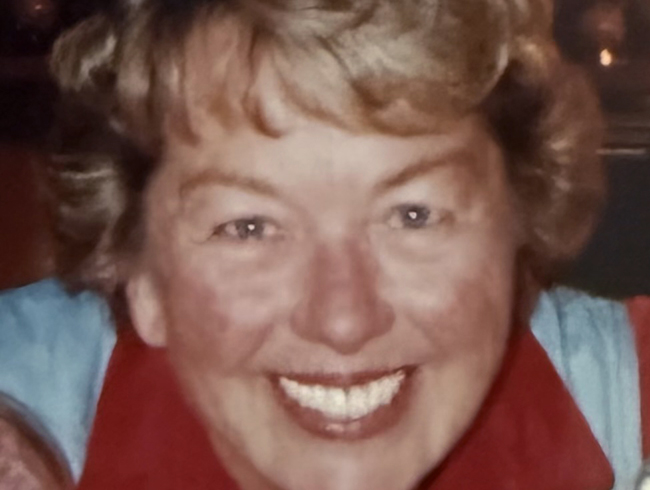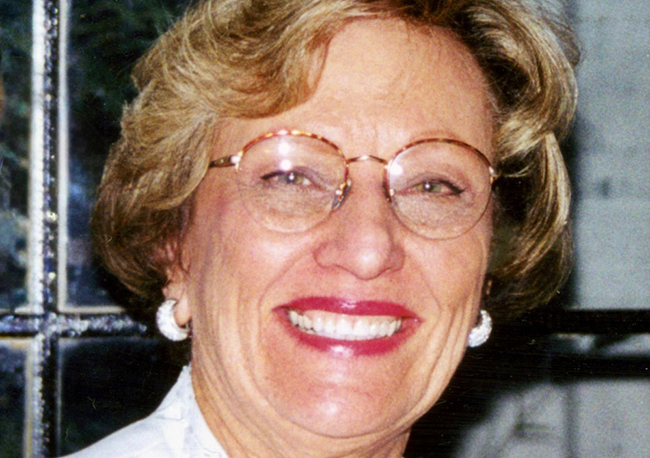Katharine Bail Hoskins
Influential professor, lover of poetry and the humanities
Katharine Bail Hoskins, a Claremont resident and longtime professor at the University of La Verne, died on August 1, 2014 at Mt. San Antonio Gardens. She was 90.
She was born Mary Catherine Bail in 1924 in Albuquerque, New Mexico to Ernest Benjamin Bail, a civil engineer, and Effie Irene Barron Bail, a former schoolteacher. Growing up, she spent time living in Denver, Colorado and Seneca, Kansas as well as in Albuquerque. In 1941, the year she graduated from Albuquerque High School, she changed her name to Katharine, emulating the spelling used by actresses Katharine Hepburn and Cornell as well as by the queens of England.
In 1944, she earned her bachelor’s degree from the University of New Mexico, Albuquerque where she majored in English and education. While at UNM, she played violin and viola in the university orchestra. From 1944 to 1946, she served in the Waves Naval Reserve as a link trainer instructor for pilots during World War II, based mainly in Texas. In 1950, she completed a master’s degree in English literature at Columbia University, New York and passed exams to advance to doctoral candidacy.
Katharine was quite busy during her tenure at Columbia. From 1948 to 1949, she worked as an editorial assistant at Columbia University Press and was the research assistant of psychologist Dr. Flanders Dunbar, a pioneer in the fields of psychosomatic medicine and psychobiology. She served as the English language editor of an Italian-American labor union newspaper in New York’s Garment District and, from 1948 to 1952, taught English at New Jersey College for Women, Rutgers University. In 1950, she married a fellow literature graduate student, Herbert Wilson Hoskins, Jr., in a ceremony held at the Columbia University chapel.
In 1954, she moved to Middletown, Connecticut, where Herbert was teaching at Wesleyan University, and gave birth to her daughter Janet Alison Hoskins. Two years later, she gave birth to twins, Susan Miranda Hoskins and Judith Ann Hoskins. In 1957, she moved with her young family to Claremont, where Mr. Hoskins began teaching at Claremont Men’s College (now Claremont McKenna). Katharine joined the Claremont Colleges community when she taught English at Harvey Mudd College.
She received her PhD in literature from Columbia University in 1965 and, beginning in 1964, spent 30 years as a professor of literature at the University of La Verne. She taught courses on modern poetry, linguistics, world mythology and on the histories of the novel, English literature and the English language. She also served as head of the English and humanities departments. Dr. Hoskins was remembered by students for her quick wit, vast knowledge and lively sense of the ridiculous.
A former student, Sean Dillon, writing a faculty profile in the University of La Verne yearbook in 1987, described Dr. Hoskins as having the quality of sprezzatura, which she had talked about as an aspect of writers and painters of the Renaissance.
“This is ability to do many things well, but do so with a studied carelessness and nonchalance, as if it were not difficult at all, but could be accomplished with apparent ease and grace,” he noted. “She provides fascinating insights into an author’s life, the society of a bygone era and the lost meanings of curious expressions with apparent facility…She is an instructor who can do many things, all with apparent grace and ease. One cannot help but admire her sprezzatura.”
In 1969, she published Today the Struggle: Literature and Politics in England During the Spanish Civil War (University of Texas Press). The book was favorably reviewed by renowned writer Stephen Spender, one of the English poets who was a subject in the book, in the New York Review of Books.
In 1988, Dr. Hoskins delivered the convocation address at the University of La Verne’s commencement. She had to fight for the humanities program at La Verne (since it was often threatened by shifts to professional training), so she used her speech to the new graduates to explain why the humanities were important.
Academics, who Tom Lehrer called “ivy-covered professors in ivy-covered halls,” were often seen as being engaged in esoteric theory with little real-world application. She traced how the idea of the “liberal arts” developed in opposition to the “servile arts” since these were the arts of free man, not slaves (or women). They were studied only by citizens, but “The liberal arts weren’t entirely safe for citizens. Socrates was condemned to death by the democratic free men of Athens because they concluded that examining everything could be carried too far.” What lay behind all true progress, Dr. Hoskins continued, was what Thorsten Veblen called “idle curiosity,” a desire to try to solve a puzzle simply because it was puzzling.
She encouraged students to “find out, if you haven’t already learned it, that the free play of the mind is indeed play; it’s a rough, tough game, but it’s fun, and that’s why people keep playing it, however difficult Church or State or Marketplace may make it. And remember, it’s idle curiosity that makes the wheels go round.”
“My mother taught many students over her professional life,” Janet said. “But we as her daughters were her longest project, and we have probably learned more from her than anyone else. We remember her for her strength and fortitude (which earned her the nickname we gave her of ‘Momument’) and also for her sweetness and affection for singing, for tennis, for drawing and for spending time with us.”
Dr. Hoskins’ daughters were all inspired by their mother’s love of literature and her dedication to global causes ranging from the campaign against nuclear weapons to the promotion of civil rights to the fight against climate change. Janet and Judy both became educators and Sue is an editor of documentary films and television,
After she retired from the University of La Verne in 1994, Dr. Hoskins remained active in civic organizations, including the American Civil Liberties Union, Amnesty International, the Democratic Party and Reading for the Blind where she volunteered for seven years.
In 2004, Katharine and Herbert moved to Mt. San Antonio Gardens, where she organized a poetry reading group and delivered lectures on modern poets and on the history of the English language.
Dr. Hoskins was talented at drawing portraits, many of them somewhat satirical sketches of public figures, and produced many paintings and illustrations. She played the violin and the viola enthusiastically with chamber music groups and orchestras in Claremont. She had a prodigious memory for everything from the highest forms of verse to the silliest little ditties of the musical stage. She and her husband also loved to play tennis, playing on the campus doubles circuit, continuing into the last decade of their lives.
But it was her love of literature and especially poetry which seems to have touched the largest number of people, from her many students to colleagues and fellow residents of the Gardens who joined her to share their favorite poems over the years. Dr. Hoskins had memorized numerous works by Keats and Yeats, Shakespearian sonnets and the love poems exchanged between Elizabeth Barrret Browning and Robert Browning.
She traveled with her husband and family to La Misión, Baja California every year for 18 years, and also traveled to Europe and Indonesia. She and her husband lived and taught in Cheltenham, England for a semester, and she directed a study abroad program in Athens, Greece in 1980-81, where she taught classical mythology.
Dr. Hoskins was predeceased by her husband Herbert, who died in 2009 at the age of 88. She is survived by her three daughters, Janet Hoskins Valeri of Santa Monica, Susan Hoskins Hunter of Sierra Madre and Judith Hoskins Robinson of Reno, Nevada, and by her sister Ann Bail Howard. She also leaves six grandchildren, Ian, Lauren and Leslie Robinson, Sylvana and Artemisia Valeri, and Christopher Hunter.
On September 5, 2014, the cremated remains of Herbert and Katharine Hoskins were buried side-by-side in the Los Angeles National Cemetery. For her epitaph, her family chose a short saying inspired by lines in William Butler Yeats’ “When You Are Old and Gray”: “How many loved your moments of glad grace/And loved your beauty with love false or true/But one man loved the pilgrim soul in you. . .”
“This line, which we shortened to ‘we loved your pilgrim soul,’ speaks to the enduring value of loving someone for her idealism, her courage and her adventurousness,” Janet said. “This is what we loved in our mother, and this is how we will remember her.”
Anyone who would like to share memories of Katharine Hoskins for a memory book being put together by her daughters is asked to send materials to 410 Churchill Road, Sierra Madre CA 91024 or email jhoskins@usc.edu.










0 Comments